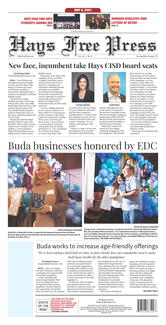
by Anita Miller
Austin’s tight real estate market is continuing to influence home sales, price and availability in Hays County, where the most recent Central Texas Housing Market report shows Hays County leading the region in some key indicators of the market’s overall health. The latest report puts Hays County at or near the top in terms (comparing this September to last September) of median home price (which rose 15.1% to $310,000), sales dollar volume (50.3% to 487 sales), home s...
by Anita Miller
Austin’s tight real estate market is continuing to influence home sales, price and availability in Hays County, where the most recent Central Texas Housing Market report shows Hays County leading the region in some key indicators of the market’s overall health. The latest report puts Hays County at or near the top in terms (comparing this September to last September) of median home price (which rose 15.1% to $310,000), sales dollar volume (50.3% to 487 sales), home sales (50.3% to 487 homes‚) new listings (rose 40.6 % to 485 listings).
Over the same time period, active listings tumbled 43.1% to 558 listings and pending sales increased 42.9% to 480. Housing inventory dropped by 1.5 months to 1.5 months.
 In Austin, median home price in the same period rose by 13.8% to $420,000, residential sales grew by 27.1% and sales dollar volume increased by 50% to $1,018,324. Pending sales were up 16.6% to 1,164 while active listings were down 24% to 1,164. Monthly inventory decreased 0.4% to 1.4 months worth of inventory.
In Austin, median home price in the same period rose by 13.8% to $420,000, residential sales grew by 27.1% and sales dollar volume increased by 50% to $1,018,324. Pending sales were up 16.6% to 1,164 while active listings were down 24% to 1,164. Monthly inventory decreased 0.4% to 1.4 months worth of inventory.
Across the region (city of Austin and Travis, Hays, Williamson, Bastrop and Caldwell counties,) sales dollar volumes grew by 51.87%. Median home prices were up by 12.1% to $355,000 and new listings increased 5% to 3,539. Pending sales jumped 28.2 % to 3,767 and active sales fell 49.9% to 3,708 listings.
“The housing market is pumping billions of dollars into our region’s economy at a time it’s greatly needed, but we also need to be cognizant of the impact such rapid growth is having on record-low inventory levels and rising home prices,” Romeo Manzanilla, Austin Board of Realtors president, said. “Austin’s suburban markets have historically offered housing stock at lower price point that’s created opportunity for people when buying or renting inside Austin city limits was not an option. Now, these markets are showing the same gains in prices and declines in inventory as we’re used to seeing in Austin, putting pressure on the market as a whole.”
Vaike O’Grady of Zondo Real Estate Group said the fact the city of Austin has such a limited number of residential lots is forcing developers to move out of town where land is more available and less expensive.
Homes simply can’t be put on the ground fast enough to meet demand in suburban markets, Grady said.
“We need to remove barriers to new construction and open up more building opportunities across the region to create more inventory for buyers,” Grady said. “Austin’s economy is bouncing back better than most cities, allowing more people to make a move to a home that meets their needs.”
“The Austin area needs more housing supply at all price points in order to stabilize home price growth and help make ownership accessible, especially for first-time homebuyers,” Manzanilla said.








